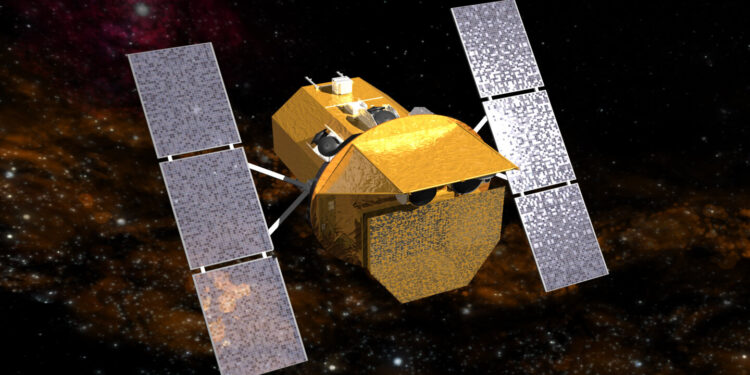Concept art for the Neil Gehrels Swift Observatory. Credit: NASA. All rights reserved.
A rare and extremely bright X-ray burst has been observed in the Small Magellanic Cloud, a dwarf galaxy close to our own galaxy, the Milky Way. The observations, made by the Neil Gehrels Swift Observatory and other telescopes, were described by an international team of astronomers led by Penn State scientists as part of the Swift team. Researchers attributed the explosion to one of the brightest nova flares ever produced by a white dwarf binary star system.
The observations were described in a paper recently published in the Monthly Notices of the Royal Astronomical Society.
“This is only the second time we have observed such a bright explosion of this type of white dwarf binary system,” said Thomas Gaudin, a Penn State graduate student and first author of the paper. “We hope this event will provide more information about how these explosions are produced and help us better understand this mysterious binary class.”
The system that produced this explosion is called CXOU J005245.0–722844. It was recently identified by members of the Einstein Probe team and confirmed by the Swift team as the seventh known example of a Be/White Dwarf X-ray binary. Be/White Dwarf binaries are binary systems in which a white dwarf star orbits a hot young star surrounded by a disk of stellar matter. Astronomers expect these binaries to be commonly observed, Gaudin said, and the lack of known examples is a mystery.
“Novae are explosions that occur when material from a nearby star is deposited on the surface of a white dwarf,” Gaudin explained. “Once enough material has accumulated, the surface undergoes rapid thermonuclear fusion which creates the explosion. Most novae are events that reach moderate luminosities and decay over the course of several weeks. This nova is strange not only in its extremely luminous behavior, but also in its extremely luminous behavior in its short duration.
Multi-wavelength light curve of CXOU J005245.0−722844 emission behavior containing I-band data taken by OGLE, uvw1-band data taken by Swift UVOT, and 0.3 to 10 keV data taken by Swift XRT. In the lower panel, black dots represent observations in which CXOU J005245.0−722844 was detected by Swift XRT. Downward pointing arrows represent the upper limits of the count rate during observations where CXOU J005245.0−722844 could not be detected. Credit: Monthly Notices of the Royal Astronomical Society (2024). DOI: 10.1093/mnras/stae2176
The thermonuclear reaction during nova is similar to the explosion of a massive hydrogen bomb: the explosion produces electromagnetic radiation that can be seen by telescopes on Earth and in orbit around Earth. According to the researchers, the nova was visible at optical wavelengths, or visible light, for a little less than a week and in X-rays for a little less than two weeks.
“We will need follow-up observations to better understand the physics that led to such an explosion, but this is an important first step in better understanding these systems and potentially why we haven’t seen as many of them than expected,” said Gaudin.
More information:
TM Gaudin et al, CXOU J005245.0−722844: discovery of a Be star/white dwarf binary system in the SMC via a very fast super-Eddington X-ray explosion event, Monthly Notices of the Royal Astronomical Society (2024). DOI: 10.1093/mnras/stae2176
Provided by Pennsylvania State University
Quote: Rare ultra-luminous nova spotted in the Small Magellanic Cloud (October 17, 2024) retrieved on October 18, 2024 from
This document is subject to copyright. Apart from fair use for private study or research purposes, no part may be reproduced without written permission. The content is provided for informational purposes only.



